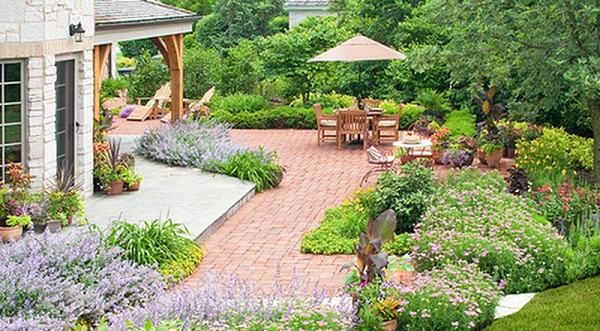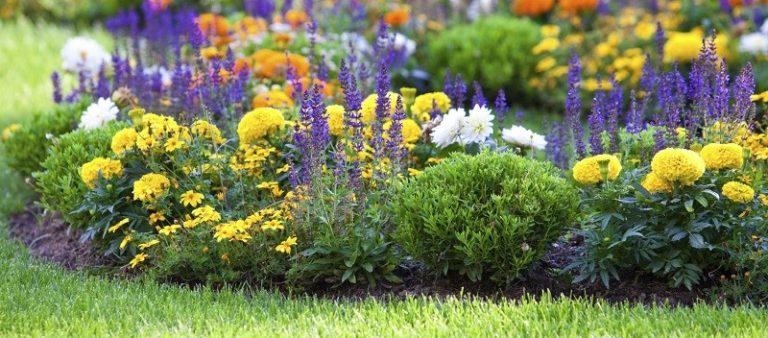Borders made of herbs
The plot is so small, and so I want to plant herbs, have a flower garden, a small vegetable garden, a lawn for children, how to place it all in a small yard? First of all, you need to plan everything correctly. For example, borders along a flower garden or vegetable garden can be decorated with herbs, and flower beds can be beautiful and useful.
A garden border is a strip 15 to 35 cm wide of densely planted plants of the same species. The basis for the border can be both annuals and perennials. However, in recent years, borders made of herbs have gained particular popularity, which perform several important functions at once:
Divide plants;
set off flowers;
drown out weeds;
protect young crops from wind and frost;
become an almost impassable obstacle for slugs;
strong smell repels many insect pests;
serve as an additional source of raw materials for medicinal and culinary preparations.
Spicy herbs for the border
There are dozens of spicy and medicinal herbs that, growing, can form a lush, suitable for cutting border. Unfortunately, some of them freeze out or remain very small.
Basil
Basil is a beautiful, fragrant, annual plant, an excellent healer and a favorite spice. Basil forms a beautiful branched and very ornamental shrub, depending on the variety it reaches a height of up to 60 cm. Basil is grown for its valuable aroma and used as a seasoning. Basil, like most herbs, loves warmth and open, sunny areas are protected from drafts, with fertile, well-drained soil. On constantly moist and heavy soils, the plant develops poorly and dies. Basil is used for various dishes, salads and preserves. More about growing basil.
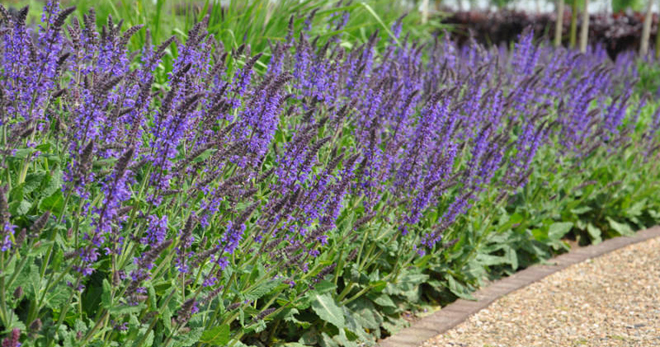
Hyssop officinalis
Hyssop can become a fairly tall hedge, as it reaches 80 cm even with unstable care. It grows well on any soil, winters without problems. It needs transplanting or dividing the bushes every 4-5 years and in a haircut in the fall. It is propagated both by seeds (sowing is possible both for seedlings and in the ground) and by cuttings.
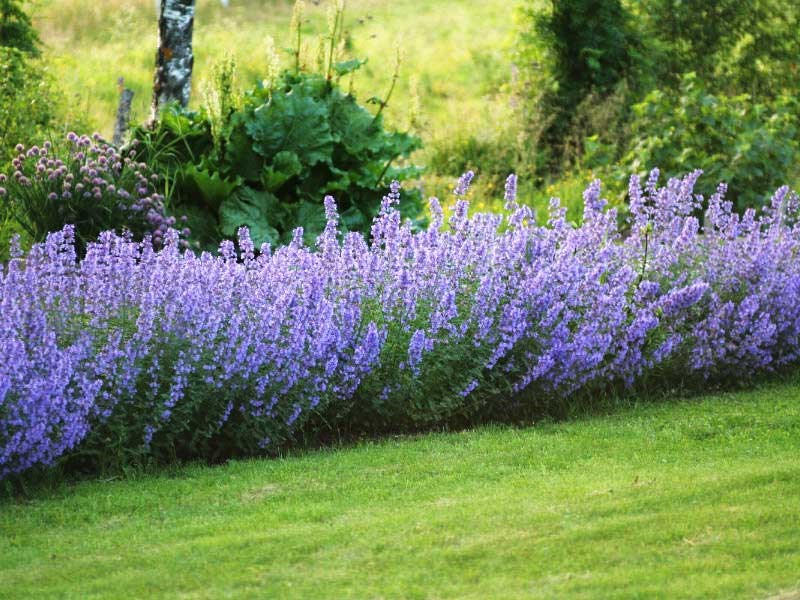
Catnip
Catnip is named so for a reason – your fluffy pets will be happy with the appearance of such a border. You can sow catnip for seedlings in April or directly into the ground in May. The bushes grow actively, so they will have to be thinned out or immediately planted at a distance of 25-30 cm from each other. In one place, catnip grows without problems for 3-4 years.
Oregano (oregano)
Common oregano (oregano, frankincense, oregano) is a perennial fragrant plant that grows in bushes 30 to 70 cm high. Thanks to strong roots, oregano is able to grow independently in the garden. Its leaves are small, ovoid in shape with a sharp tip. Flowering is found in a wide variety of shades, since today more than 20 decorative varieties of this plant have been bred. Oregano is used not only for delicious tea, but also as a medicinal herb. More about growing oregano.
Narrow-leaved lavender
Lavender is a very useful plant, it has been used in folk medicine since ancient times. In addition to its healing properties, lavender is used in cooking. This is a great seasoning for meat. The flowers are used to make flour products and sweet dishes, as well as as aromatic additives in juices and drinks. Lavender is also used in the fight against moths. The pedicels are cut, dried and stuffed into specially sewn pads, which are hung next to clothes.
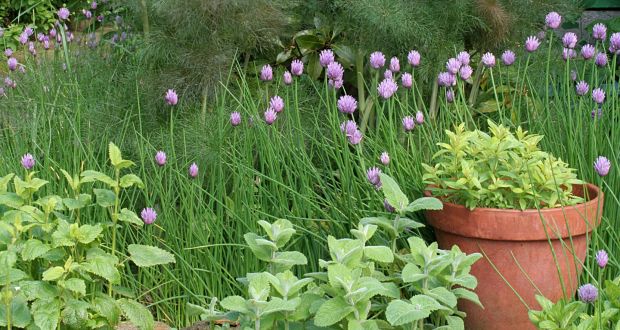
Chives
Perennial bulbs can be grown not only on a feather, but also as ornamental plants. The bright flowers of chives do not delight the owners for long, but juicy greens, with proper care, are preserved until the cold weather. Chives are planted in April-May, and then the bushes are regularly divided. 1-2 times per season, organic fertilizer should be applied under them, but the last time this should be done no later than the end of July. For the winter, onion leaves are completely cut off, and in the summer this procedure can be carried out several times.
Tarragon (tarragon)
Tarragon propagates by dividing the bush, cuttings or seeds, which are sown in early spring or autumn under snow. Caring for it is minimal – watering in the heat and fertilizing with mullein infusion once a season. Since tarragon likes light soils, it will appreciate loosening or mulching the soil. It is important to remember that tarragon is a fairly tall plant, and therefore not suitable for everyone as a border.
Mint
Mint can be sown directly into the ground (in April), planted with seedlings (in May or August), propagated by cuttings or rhizomes. It grows well in the sun or in the shade. Throughout Ukraine, mint hibernates without problems and grows very actively, so you will have to trim the border regularly, and ideally dig a curb tape into the ground to a depth of 20 cm on both sides. More about mint
Thyme
There are many varieties of thyme and they are all good in their own way. Different varieties can reach a height of 5-25 cm, be creeping, multi-colored, or have an unusual smell. The beauty of thyme is that it can be propagated both by cuttings and by dividing the bush or seeds. In addition, it is completely undemanding to fertilizers, watering, easily tolerates winter and needs only annual pruning.
Sage
Medicinal sage is a perennial plant that can be sown in May or September directly into the ground. The distance between the bushes should be chosen depending on the variety, since the height of the plants varies from 30 to 120 cm. Sage responds well to the introduction of organic matter and mineral fertilizers, is undemanding to watering, and it needs to be cut off starting from the second year of life. More about growing sage
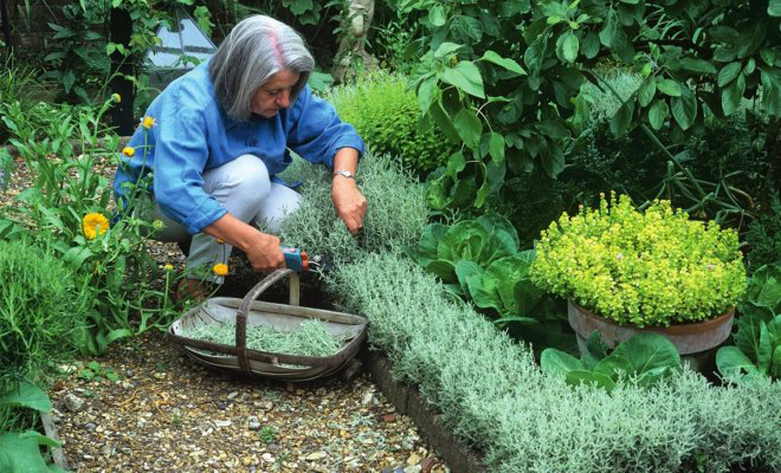
How to grow a border of herbs
Despite its lush appearance, growing a grass border is very simple, and with the right selection of plants, it remains decorative for more than one season. It takes much less care than any flower bed or bed, but you should not completely forget about it, especially in the first year.
Do not make the border too wide – it will prevent you from caring for the plants it encloses. Also remember that the border should be lower than the main “inhabitants” of the beds or flower beds.
Border of herbs
Decorating borders is a simple process, but you can spend more than one day on it. It all depends on the size (length) of the curb that you have outlined. The technology itself is simple and consists of only six steps.
1. Use pegs and tape to mark the perimeter of future curbs.
2. Dig a trench 15-20 cm deep in this place, and set the excavated soil aside.
3. Pour a thin layer of drainage at the bottom of the trench (if you have sandy or sandy loam soil on your site, this step can be skipped).
4. Mix the soil with organic fertilizer, pour back into the trench, lightly tamp and spill.
5. Plant the young plants chosen for the border a little denser than in a normal bed in the case of annual cultivation.
6. Water the plantings again and mulch the border.
Caring for a border of herbs
There is nothing difficult in caring for a border, it is in many ways similar to lawn care, only you need to mow much less often.
In the first month, herbs need a large amount of sun and moisture for good growth. It is advisable to water the soil little by little, but often, preventing it from drying out.
In order for the border to be even and neat, do not forget about haircuts – they begin even before the bushes close into a single green mass. Trimmed tops in time activate branching, so in the first season, carry out this procedure about once a month. In subsequent years, borders are cut once, immediately after flowering.
Cut parts of herbs can be dried or frozen for the winter, made with oil or used in cooking immediately.
You need to feed the border with mineral fertilizers 2-3 times per season. Nitrogen fertilizing after flowering and potassium-phosphorus fertilization, carried out in mid-August to prepare plants for wintering, are mandatory. If you use only annuals in the border, you can get by with two nitrogen fertilizing in June and July.


